Amazanga is the name I was given to tell a story. It is an old story. The story says that we humans are born magical beings, that we are born into a magical universe.
The story describes the Earth as our beloved, and speaks of her ancient trees as being like our closest cousins. The story tells us that we are here to evolve, and says that when we breathe and dance and love amid age-old primary forests, that it is then that the Earth most naturally and gently nurtures our evolution. I discovered this story while dreaming on the forest floor.
Surrounded by the pristine headwaters of Ecuador’s Rio Putomayo, I traveled with a small group that included Quechwa and Secoya Indians, and a man they call a “vegetalista,” an indigenous elder versed in the arts of shamanic healing. The vegetalista gave to my compatriots names by which the Indians could better remember us. To me he gave the name Amazanga, warning that it carried the weight of a great responsibility, and that if I wished then a different name could be found. Amazanga, he explained, means the whole of the rainforest—its plants, its creatures, its peoples—its spirit. I accepted the name.
After returning home from the forest, I began to draw pictures, not as an artist trained by years of study, but rather out of a strange compulsion, like something a storyteller might feel when pulled along by visions beckoning for expression. The pictures developed slowly and after several years I began realizing that they formed a narrative, a story, and that sharing this story was the responsibility given to me by the name Amazanga.
There are 26 pictures, each representing what I feel is a point of passage, a mythic place in our lives that we must all pass through. I’ve included a few of them below and hope the pictures express this intimate mystery, as well as the wonder embedded in the natural world. I hope also that these pictures reflect honestly the spirit of the vegetalista I met in the forest, a spirit echoing the guiding voices of an archaic heritage—a heritage to which I believe we are all magically born.
“[E]very portion of existence is interrelated and inherently connected through the powerful, pulsating, alive, caring, creative, ever changing web of cosmic energy…You are much more wondrous then you realise.”
~ Barbara Marciniak
The Buddha attained enlightenment, then departed.
A bodhisattva also attains enlightenment, but then remains part of the world to assist others on their journey of awareness. How does a bodhisattva assist? By becoming a cosmic presence that continually manifests the dynamic web connecting ourselves with each other and the greater universe. Wondrous web imagines two bodhisattvas, then sun, the earth, the moon.
As Chief Seattle put it, “This we know. All things are connected.”
“When you walk across the fields with your mind pure and holy, then from all the stones, and all growing things, and all animals, the sparks of their soul come out.”
~ Ancient Hasidic saying
“[S]oftly entice the fountains of life, playfully charm them to rise from the roots…”
~ Goethe
Roots imagines the Earth as a life-inducing womb, with numerous figures at play, inter-relating with each other, rising upwards toward the forest floor.
“Because the soul has such deep roots…”
~ Thomas More
Deep roots imagines the earth as a womb with figures rising upward toward the forest floor, their play symbolic of the many dramas we act out with each other on our journey towards peace. Because many cultures celebrate old trees by wrapping them with ropes, I have drawn ropes as the connecting link between humans and trees.
I have long been fascinated by the number 108, a sacred, astronomical number reappearing in the cosmologies, architecture, customs, and myths of many traditional cultures. And so there are 108 figures in the picture. Also, it is interesting to note that in Genesis the first man is named Adam, which is from the Hebrew word adama, meaning: earth, dirt, the ground below.
“In true prayer you hear only the song.”
~ A Course in Miracles
My pictures imagines a world coloured by earth, water and sky, a world enriched by trees and plants, a world filled with the sounds of men and women living as evolving spirits. My pictures imagine a beautiful world, a dream.
Prayers imagines this dream constantly being dreamed anew by men who are called “Indian.” The word was used by the arriving Spanish amazed by how close the Native Americans lived to Nature. In the vernacular of the times, “one with nature” was expressed as being “in Dios,” or “endios,” meaning one with God. Thus—en-dian. Indian.
Each of the men expresses a characteristic that when combined in a single person results in a fully balanced life. The man on the right is in ecstasy, feeling his feelings so deeply that he becomes his feelings. The man on the left is lost in thought, thinking his thoughts so deeply that he becomes his thoughts. The man in the center expresses the equanimity that balances and harmonizes the two.
“The hidden well-spring of your soul must rise and run murmuring to the sea; and the treasure
of your infinite depths would be revealed to your eyes.”
~ Kahlil Gibran
Hidden Spring imagines a young boy being called into the night forest, discovering a spring lit up by the aura of the surrounding energy. Special places with their own beckoning vortexes of energy exist throughout the world, but are especially numerous in the depths of pristine forest. Such places beckon us, imparting wonder and self-knowledge when we let go of our fears of darkness and the unknown.

Through The Trees images a woman feeling the richness of the surrounding forest. The sun filters through the branches leaving designs of light on her body. She sits nestled between tree trunks that open up into magical portals of movement and color. You are invited to imagine yourself entering through these magical portals, invited to journey ‘through the trees.’
“There is no difference between ‘I want to have a child’ and ‘The universe wants to have a child.’ The embryo that starts to grow in the womb relies on billions of years of intelligence, memory, creativity and evolution.”
– Deepak Chopra
Rites of Passage imagines a mythical context for understanding death, or for that matter, any major change. The six figures in the picture respond differently to the inexorable movement approaching them. Two figures raise weapons (spear, bow & arrow) and defy the movement, fearing the unknown. Two other figures make music (drums, didgeridoo), responding creatively to the unknown. The remaining two figures simply reach for leaves and allow the movement to carry them where it will, surrendering to the unknown. The six figures were drawn from models I created from dried vine roots. It took 2 years to find all the pieces. Each figure was put together from about a dozen glued pieces.
Origins harks back to the archaic, male and female nurturing their young. This nurturing, the origins of what we call love, predates human existence. In other words, life always begins with love, the nurturing expressed between parents and their young, nurturing that extends far back to the very ‘origins’ of life.
“Aboriginal myths tell of totemic beings who wandered in the Dreamtime, singing out the name of everything that crossed their path—birds, animals, plants, rocks, waterholes—and so singing the world into existence.”
– Bruce Chatwin
Totems are everywhere, creations that reflect how individuals and cultures define their myths, ideals, inspirations. During rituals of heightened awareness a totem may come alive, inspiring spiritual understanding and healing. Birds have often been carved onto totems as symbols of an expanded perception of freedom. Interestingly, I chose a bird for this imagine knowing only its Japanese name. I was amazed to later discover that in English it is called a ‘merlin,’ namesake of the famous Druid shaman from Arthurian legend.
“Naked I came from my mother’s womb, and naked I shall return there.”
– Bible
Womb imagines us safe in a sanctuary of love emanating both from within as well as without. Large roots encircle the man like protective arms, the embrace inspiring a passionate self-acceptance. The picture initially featured a woman figure as well, but I realised the Earth itself was the greatest expression of the feminine, wherein life is created as well as cradled.
Tribe imagines 19 people that will meet during their lifetimes and reflect for each other the varied archetypes of human character, archetypes such as the healer, the warrior, the mother, the hunter, etc. As we interact with these 18 other people of our tribe, we integrate these archetypes into a fulfilling understanding of who we are. Why 19? Add 1 and 0 to make 10, and think of 1 and 0 as numbers representing wholeness.
“I hear a sound as of human voices. For the water is like a chattering.”
– Goethe
Sit beneath falling waters and the rush of sounds will slowly metamorphose into voices. Voices is my only image inspired by an actual place. Not far from where I live in Japan there exists a special mountain called Seppiko. One day, while climbing far upstream, I felt compelled to peer over a large group of boulders, discovering behind them an enchanting place hidden from view. Two rising rock walls balanced a large rock, with waters falling around it onto a stone where one could actually sit. Voices imagines a man sitting on that stone, listening to the waters become like voices, guiding voices.
Love elephant and want to go steady?
Sign up for our (curated) daily and weekly newsletters!
Apprentice Editor: Cami Krueger / Editor: Travis May
Photo: Art by Erez Sitzer



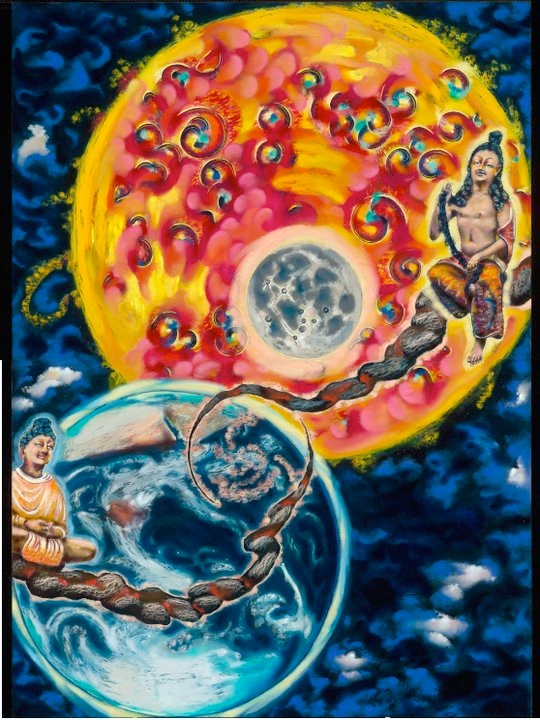
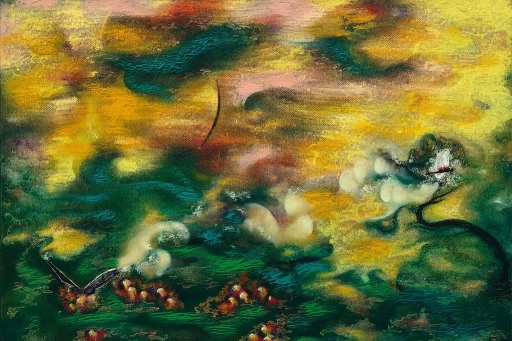


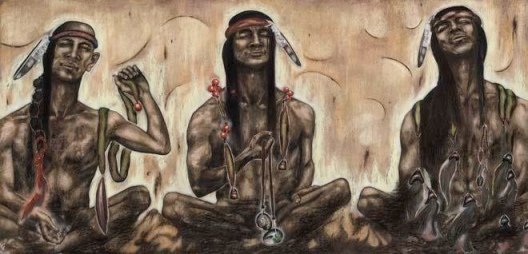
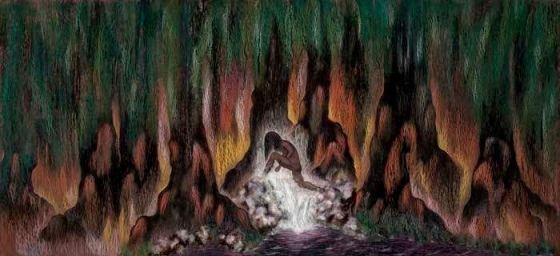

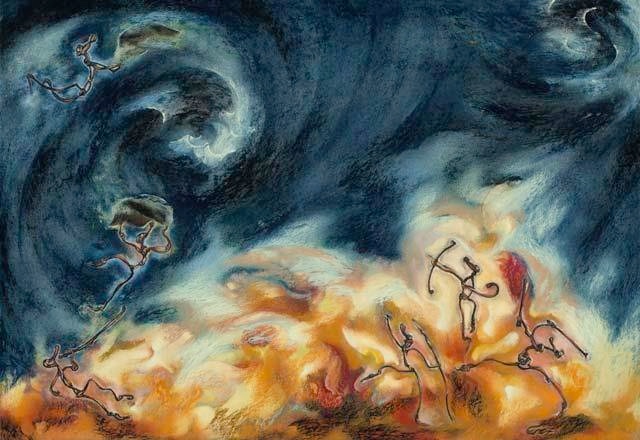
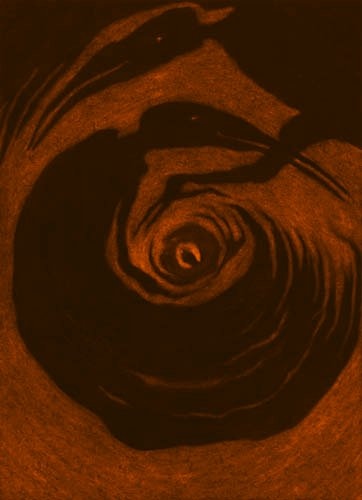
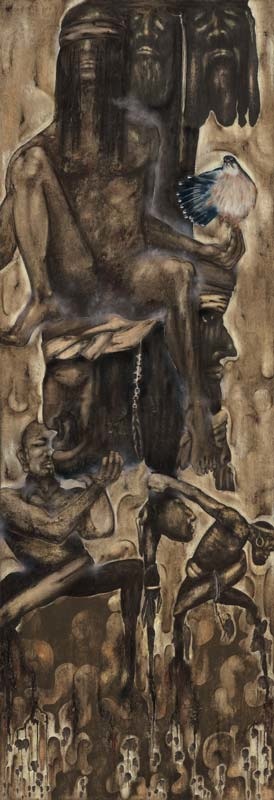
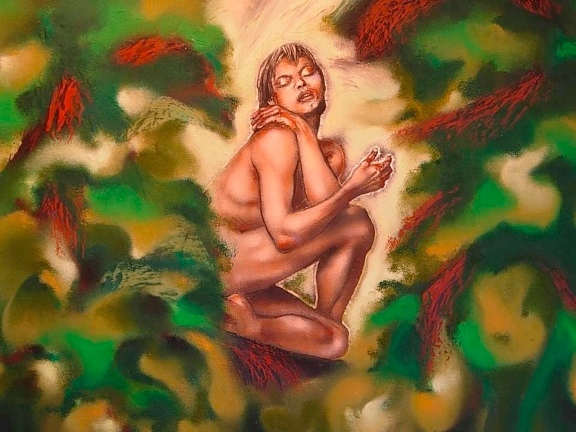
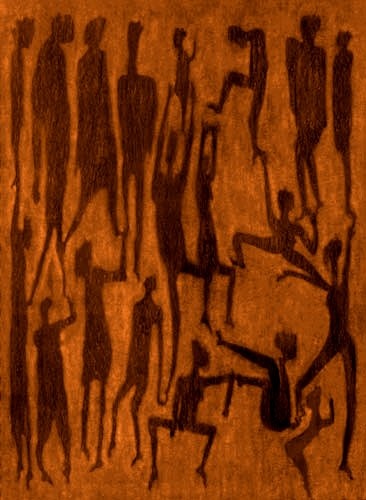









Read 0 comments and reply